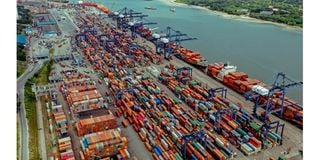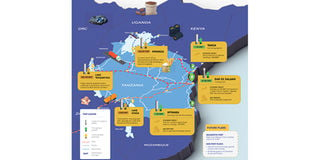Tanzania's Ports: The rising powerhouse of East Africa’s maritime empire
Sponsored by Tanzania Ports Authority

Jasper A. Kwayu had the opportunity to interview Plasduce Mbossa, the Director General of Tanzania Ports Authority (TPA) and the driving force behind Tanzania’s ambitious port modernisation strategy. Mbossa discussed the bold initiatives that have catapulted Tanzania’s ports onto the world stage, not just as players, but as leaders in East African trade.

Plasduce M. Mbossa, Director General, Tanzania Ports Authority.
Q: Mr Mbossa, Dar es Salaam Port has seen impressive growth in the past year. What’s driving this transformation?
The growth we’re seeing at Dar es Salaam Port is a result of strategic investments and focused modernisation efforts. We’ve moved 23.7 million tons of cargo in 2023/2024, a 110.4 percent increase from the previous year. A big part of this success comes from a $250 million investment from DP World, which helped us slash ship waiting times and increase efficiency.
We’ve modernised infrastructure, improved cargo handling, and revived the TAZARA railway, connecting the port to Zambia’s Copperbelt. Now, over 2.25 million tons of Zambian copper, maize, and wheat flow through Dar annually. But it’s not just volume; we’ve reduced container costs by 62.5 percent, making Dar es Salaam not only fast but also cost-effective.
Q: We understand there have been major developments at Terminal 1. Can you share more details?
Terminal 1, or T1, has been one of the standout improvements at Dar es Salaam Port this year. Traditionally, we only handled one container vessel at a time in T1. However, in September 2024, we set a historic milestone by managing two container vessels simultaneously for the first time. Even more impressive was that we introduced the twin-lift system, a technique that allows us to lift and handle two containers in one cycle, significantly speeding up operations. This was a first for Dar es Salaam, and it’s already boosting our capacity to process cargo faster than ever before. It’s a major step forward in our goal to become a logistics hub for East and Central Africa.
Q: Tanga Port has also been making headlines for its growth. How has it evolved?
Tanga Port has gone through a remarkable transformation. After a TZS 429.1 billion investment, Tanga’s infrastructure has been overhauled. We deepened the draft to 13 meters, installed new cargo-handling equipment, and boosted capacity. Tanga handled 1.19 million tons of cargo in 2023/2024, a 134.3 percent increase from the previous year. It’s now a key player for Zambian petroleum exports, which doubled to 57,306 tons this year. Tanga isn’t in Dar es Salaam’s shadow anymore; it’s ready to compete with the best.
Q: Mtwara Port recently set a new record with the arrival of its largest vessel. What’s the significance of this?
Yes, on September 20, 2024, Mtwara Port welcomed the MV HG Tramontane, the largest vessel we’ve ever received, measuring 240 metres and carrying 458 containers. This marks the beginning of the 2024/2025 cashew season, and the ship’s early arrival signals that Mtwara is ready to handle larger volumes of agricultural exports. We’re prepared to meet President Samia Suluhu Hassan’s directive to export all cashews from the southern regions through Mtwara. This is just the beginning of Mtwara’s growth as a key agricultural hub.
Q: How do Tanzania’s inland ports play into the overall strategy for regional trade?
Our inland ports – Lake Tanganyika, Lake Victoria, and Lake Nyasa – are the lifeblood of trade for our landlocked neighbours like Burundi, Rwanda, and the DRC. In 2023/2024, Lake Tanganyika Port handled 302,735 tons of cargo, achieving a 101.6 percent performance rate. Lake Victoria processed 236,567 tons. These ports may not be as visible as Dar es Salaam or Tanga, but they are critical. They ensure that these countries remain connected to global markets through Tanzania.
Lake Nyasa is still developing. It handled 2,620 tons, or 11.9 percent of its target, but we’re investing in infrastructure, including the new Mbamba Bay Port, which will connect Nyasa to Malawi and unlock new trade routes. It’s all part of a long-term strategy to build a comprehensive, interconnected trade network.
Q: Tanzania’s ports are increasingly serving not just Tanzania, but also neighbouring countries like DRC, Burundi, and Rwanda. Can you speak to the growing regional role of Tanzania’s ports?
Absolutely. Tanzania’s ports are the gateway to global markets for DRC, Burundi, and Rwanda. In 2023, Dar es Salaam handled three million tons of DRC transit cargo, and we’ve set aside 10 hectares at the Kwala Dry Port, specifically for Congolese goods, ensuring faster clearance and smoother operations. Our ports are helping to divert more business from Kenya’s Mombasa Port, and DRC’s decision to establish a liaison office here is proof of our growing importance to the region.
Rwanda is another key partner. In 2022, we exported $103 million worth of goods to Rwanda, including gold, rice, and cement, while Rwanda sent $15.3 million worth of goods to us, including coffee and construction vehicles. These relationships are growing because of the increased efficiency and lower costs at our ports.
Q: What’s the long-term vision for Tanzania’s ports? Where do you see the TPA by 2030?
By 2030, our goal is for Dar es Salaam Port to handle 30 million tons of cargo annually. To achieve this, we’re introducing Special Economic Zones (SEZs) to integrate industrial production with port operations, creating a seamless logistical ecosystem. This will help us remain competitive not just in East Africa but globally.
We’re also expanding Tanga and modernising our inland ports to ensure Tanzania remains the trade hub for the region. The TAZARA railway will continue to play a critical role, connecting our ports to Zambia and beyond. Our long-term strategy is to make every port – whether on the coast or inland – a vital part of East and Central Africa’s trade infrastructure.
Q: Any final words on Tanzania’s maritime future?
We’re building the future one ton at a time. Tanzania’s ports are more than just points of transit. They are the engines driving the economic growth of the entire region. We’re not here to play catch-up. We’re here to lead. By the time we’re done, Tanzania will be the undisputed leader in East African trade.

Tanzania’s expanding port network.


